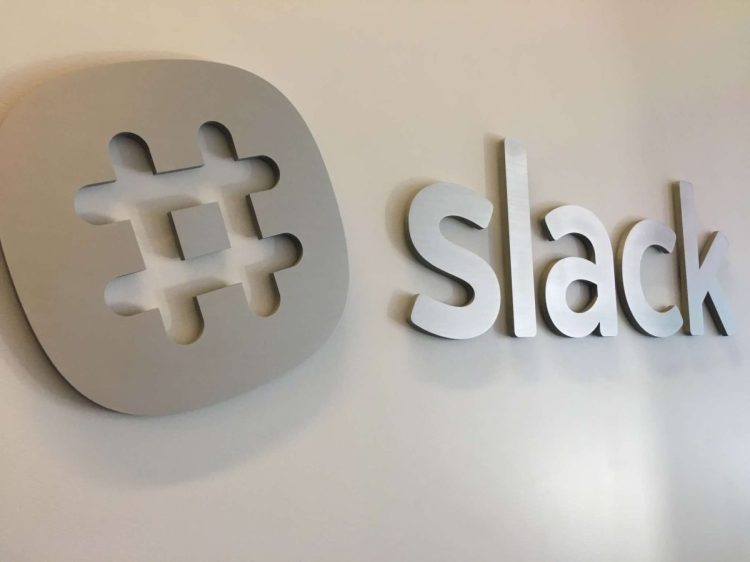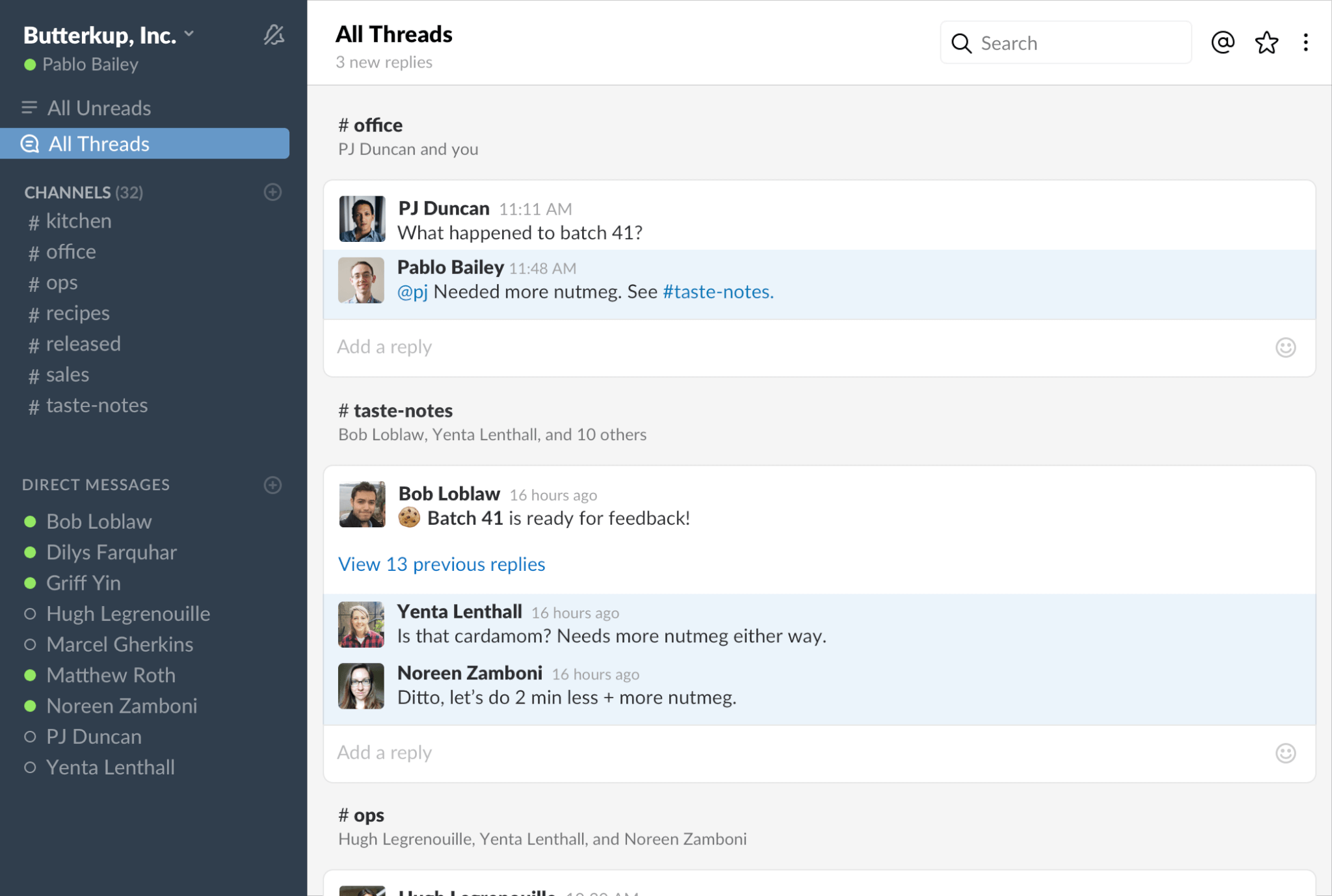Slack has introduced a feature many users, particularly those in the media, will be ecstatic about: threaded replies. With this capability, the productivity app becomes more in line with Convo, Microsoft Teams, Facebook, and other products targeting the Future of Work space. But unlike many of these traditional apps, Slack has opted to shift these threads to the sidebar pane, removing the chatter away from the main conversation.
Officially called Slack Threads, the feature has begun rolling out today and will be available for all across the web, mobile, and desktop apps regardless of pricing tier.
Previously, if you wanted to reply to a message in a channel, you’d have to @mention them and have it interrupt the main conversation. In doing so, it throws everything out of order and others will find it difficult to follow the train of thought. Now all you have to do is select the “start a thread” option from the same menu where you’d add a reaction. Then, type in your message in the pane that appears and that’s it. The original message in the channel will be denoted with a label saying there’s a reply and also who is participating in that side conversation.
Replies in the thread are arranged chronologically, not sorted based on relevance to the user. Slack’s core product lead Paul Rosania explained it was done out of an abundance of caution so you don’t miss out on something. Anyone can follow a thread and notifications are given to the original poster and those who reply, get tagged, or voluntarily subscribe to know more. If it becomes too much, you can easily unfollow a thread.
Sometimes you may want to share pertinent replies back into the main channel, so threaded replies has an option where you can take any reply and publish it back. If you’re conversing within a design channel, for example, and elect to have a side discussion about the latest layout, you might want to tell everyone what the ultimate decision is. With the “also send to #channel” element, the reply along with a summary of the original post will be published back into the respective channel.
In the left sidebar where all your channels are featured is where you’ll find a new notification link that will show you all the replies related to you.
Slack limits one reply thread per message, but you can have multiple replies in a channel. Everything will also be searchable.
Developers can also tap into this new product offering with an updated API. This means that third-party integrations and bots can work in the sidebar pane.
Easier said than done
The feature is certainly not unique to Slack, but according to the company’s vice president of product April Underwood, it’s one that hasn’t really been solved in the context of work. “In a world where it’s mission critical for people to take advantage of the transparency of Slack and learn about what’s going on in a channel, but have the flexibility to take some conversations over to the side and tuck them out of the main flow of conversation, you really introduce some complexities that haven’t been solved before,” she said.
For nearly two years, Slack says it’s been working on the right way to implement threaded replies. It counters that launching this feature was easy to do. “This is a big feature for Slack and we took a lot of time to get it just right,” remarked Joshua Goldenberg, the company’s head of design. “Over many iterations, there were a total of 7 designers, 2 user researchers, 1 [CEO] Stewart Butterfield, lots of [product managers], engineers, and [quality assurance testers] that worked on this.”
The company waged an internal discussion about whether threads should be in-line, inside the channel, or where it currently stands: part of the sidebar. Many similar tools have a more traditional setting that’s inside the channel and in-line. But Slack studied its users and discovered that the preference was more in the sidebar. While highly requested, Goldenberg’s team looked at what exactly people wanted and what the needs and workflows around the underlying request were. “It’s easy to build something that people request, but it’s important to build what people actually need,” he said.
Slack sought to highlight the craftsmanship it takes around the productivity app as another reason why it didn’t release threaded replies years ago. The company views them as side conversations, similar to the ones we have in real life, and these should not really interfere with the normal, everyday group conversations. “Threads are more special because they fundamentally change how Slack works,” Goldenberg claimed. “When we work on something so central to the experience, it demands exceptional care and attention.”
With threaded replies, teams don’t need to move conversations into private messaging, which is not indexed by the search engine. Now, there’s a side room available for discussion.
Targeting larger teams
More than 4 million people use Slack every day, which is certainly beyond simply being a productivity app for small businesses and startups. Now we’re starting to see larger teams use it. With more than 1.25 million paying users, more conversations are likely, which is why threaded replies are needed. Think about it: In real life, you’ll have a group discussion that drastically deviates to random or tangential topics. How often have you heard the moderator say “Take this offline”? This is exactly what Slack wants to do with threaded replies.
“More companies are communicating with each other on Slack. People are creating channels within their Slack teams to communicate with vendors, partners, and employees. They’ve done ad projects where they’re sending feedback, comps, etc. to agencies enabling them to move faster than traditional email. We’re starting to see this use case become prevalent. It’s great for companies because it’s not clogging up inboxes and it’s getting [information] into the right channels to the right people,” the company’s former chief marketing officer Bill Macaitis once told VentureBeat.
For Goldenberg and Underwood, this feature is “an incredibly important feature” and one that underscores the impact Slack has on the workplace across businesses of all sizes. “We have graduated beyond smaller teams using Slack. As we graduate to larger deployments in many of the Fortune 100 customers using Slack, as we see more businesses of every size around the world using Slack, we have to look at some of the features that map to how people use [it] to get work done,” Underwood said.
Introducing this feature isn’t a shock since there have been rumors for months about when it would launch. In April, Butterfield said Slack had been prototyping “various forms of threaded messaging internally for months” — something that the company’s head of user research Christina Holsberry Janzer, echoed during a demo of the new feature. Butterfield remarked at the time that threaded messaging “should hopefully arrive” later in 2016. Well, he was a bit off on the timing.

Above: Slack has been working on a threaded comments feature since at least 2015.
If you’re thinking of Slack as merely a chat app, the company begs to disagree. “Slack is not a chat tool. It’s not a place to have quick real-time communication,” Underwood claimed. “It’s a place where people are producing real work product. They’re collaborating around it. They’re creating an archive which anyone can plug into when they join the company. It’s really critical for us to tackle problems that haven’t needed to be solved before. Threads is absolutely in the top couple of features that we’ve launched in the last few years in terms of the type of uses for Slack and chipping away at one of the good problems to have: As people use Slack more, they run into challenges of information overload.”
Threaded replies are aimed at simplifying channels that become increasingly cluttered with conversations of all sorts. With such high expectations, it’ll be worth looking to see how well the feature is received and whether this new way of having side discussions resonates better than you’d expect from a traditional productivity app.






